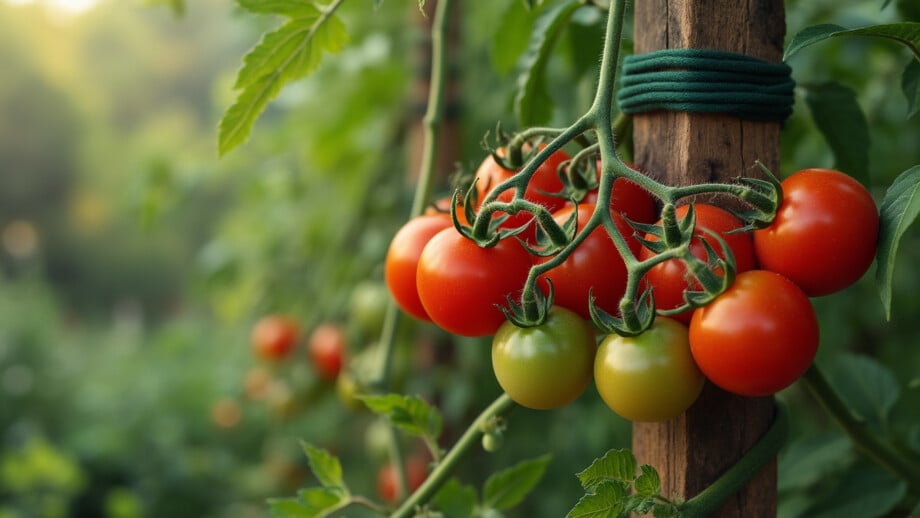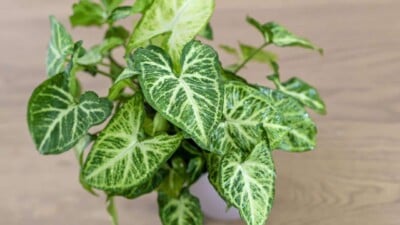Terminology
Here’s our quick-reference garden glossary containing all the terms you need to know when growing tomatoes.


Best product
for Big Blooms
Liquid Budswel
Use this superior blend as needed for spectacular crops and huge yields.
Learn moreAcidic Soil: Soil with a pH value higher than 7.0 (pH>7) is considered alkali and can be neutralized (pH of 7 being neutral) by addition of an acid (pH<7). Soil with a pH of higher than 10 (pH>10) is considered very alkaline. Alkalinity is caused by an increase in sodium compounds or sodium carbonates, which often occur as soil minerals break down. Alkaline soil has a low water infiltration capacity which means water tends to pool or stagnate on the surface. Alkaline soils can be neutralized or acidified by the addition of organic materials such as peat moss and compost or inorganic soil amendments such as sulfur which lower the soil pH. Gypsum is often used to “condition” alkaline soil because it improves the soil structure and water infiltration capacity while replacing the sodium in the soil compounds with calcium as it breaks down.
Alkaline Soil: Soil with a pH between 7.0 and 14. To lower soil pH add sulfur.
Beneficial Insects: Insects that eat or lay their eggs in other insects thereby controlling them. Used in this country since the late 1880′s they are the best known form of biological control.
Biological Pest Control: Using living organisms such as beneficial insects or parasites to destroy garden pests.
Chlorosis: A yellowing or blanching of the leaves due to lack of chlorophyll, nutrient deficiencies or disease.
Companion Planting: The sowing of seeds in the garden in such a way that plants help each other grow instead of competing against each other.
Compost: The end product of the decomposition of organic matter and biodegradable materials by aerobic and anaerobic microbes is known generally as compost. Compost is nutrient rich since during the decomposition process the larger organic compounds are broken down into their basic elemental particles that are easier for plants and other organisms to absorb. Compost serves as a great growing medium for agricultural and horticultural purposes as well as a soil conditioner. This dark brown to black soil/mulch can be easily made in the kitchen or back yard in a compost container or the more traditional pile form.
Container Gardening: Growing plants in pots and planters instead of in the ground.
Crop Rotation: The planting of a specific crop in a site different from the previous year. Rotating crops is especially critical to preventing disease and insects from getting a foot hold on certain vegetables you might plant.
Determinate: Tomato variety that produces most of their fruit all at once and grows to a limited size. Also known as bush tomatoes.
Direct Seeding: Sowing seeds directly in the soil where they are to grow, rather than transplanting seedlings.
Fertilizer: An organic or synthetic material added to the soil or the plant, that is important for its nutrient value.
Foliar Fertilizer: A fertilizer applied in liquid form to a plant’s foliage in a fine spray so that the plant can absorb the nutrients through its leaves.
Frost Date: The average yearly date that the last or first frost of the year occurs.
Fungal Disease: Respiratory and skin diseases resulting from inhalation or direct contact with fungal spores in soil and compost. Overly wet soil (40% water) and compost are the usual causes of respiratory fungal diseases such as “farmers’ lung.” Symptoms usually occur 4-6 hours after exposure and are flu-like with a high fever and aches lasting for 12 hours or more. Skin infection may result in rashes and sores.
Hardening Off: The process of acclimatizing plants grown under protection, in the greenhouse for example, to cooler conditions outdoors.
Heavy Soil: Dense soils made of silt and clay that are often very fertile but require soil amendments to improved structure as well as oxygen and water penetration.
Heirloom: Seed with desirable qualities that have a history of being passed down over many years and many generations.
Hybrid: Seed produced by artificially cross-pollinating two different varieties.
Indeterminate: Tomato variety that continues to grow and set fruit throughout the growing season. Also known as vining tomatoes.
Integrated Pest Management (IPM): An effective and environmentally sensitive approach to pest management that relies on a combination of common-sense practices. IPM programs use current, comprehensive information on the life cycles of pests and their interaction with the environment. This information, in combination with available pest control methods, is used to manage pest damage by the most economical means, and with the least possible hazard to people, property, and the environment.
Macronutrients: The major elements essential for plant growth. The major plant macronutrients are nitrogen (N), phosphorous (P), and potassium (K).

Micronutrients: Mineral elements which are needed by plants in small quantities.
Mulch: A soil covering used in gardening and agriculture to protect soil from the extremes of weather and climate by helping conserve soil moisture and moderating temperatures. Mulch helps soil retain water from rainfall and heat absorbed during daylight. It also protects soil against direct sunlight therefore keeping soil moist and cool during the hot summer months. Weed prevention is a major use for mulch. It both blocks sunlight to unwelcome weeds and smothers the seeds before they start. Mulch is also great for erosion prevention and protecting soil from the damaging aspects of heavy rains. Common materials used for mulch are: hay, straw, grass clippings, bark, sawdust, wood chips, newspaper, and cardboard. Rocks, gravel and plastic are also often used as mulch. If compost is used as mulch, it is necessary that it is fully composted and that all weed seeds have been killed; otherwise, it will actually contribute more weeds to the area.
Nitrogen (N): A macronutrient used by plants to promote rapid vegetative growth.
Organic: A term used to describe certain agricultural and food production methods which do not use toxic fertilizers and pesticides, genetic engineering, synthetic hormone stimulation, antibiotics and other practices such as irradiation and the spreading of treated sewage. Farmers, food producers and processors must meet nationally regulated standards in order to be considered organic. Products such as fertilizers, soil amendments and pesticides must also meet federal guidelines if they are to be labeled organic and given the “USDA Organic” seal. There is some confusion with the term organic as an opposite of commercial. The proper antithesis to organic is chemical or synthetic since for instance both organic and chemical fertilizers are sold commercially.
Organic Gardening: The practice of growing fruits, vegetables, flowers and other plants without the use of chemicals or synthetic products. Organic gardening philosophies and techniques vary. Some believe in only using plants and products that occur naturally in the local environment. Others are more liberal using any product so long as it is organic and is not harmful. Still others consider organic gardening to be an integral part of sustainable living, taking in to account not only if the product is organic but if things such as the fossil fuels were used in shipping and the product’s effects on the local ecosystem. Generally organic gardening is the art of growing plants using organic products such as compost, natural soil amendments, natural pesticides, and beneficial microbes and insects.
pH: The measure of the acidity or alkalinity of a substance or solution. Technically pH measures the activity of dissolved hydrogen within a substance. pH is a relative measurement with “pure” water being neutral at pH 7.0. A pH lower than 7.0 is considered acidic and a pH higher than 7.0 is considered alkaline or basic. Adding an alkaline to an acidic substance will raise its pH making it more neutral or alkaline. An acid added to an alkaline substance will lower the pH and make the substance more neutral or acidic.
Phosphorus (P): A macronutrient, or major nutrient, used to stimulate root systems and flowering.
Potassium (K): Used to promote overall plant vigor and development of healthy stems. Potassium is a macronutrient.
Season Extender: Techniques and equipment used to extend the growing season in both spring and fall. Examples include greenhouses, cold frames, hotbeds, row covers, and products such as Wall O’ Waters.
Soil Amendment: Any material added to soil to improve or change its characteristics. Soil amendments are utilized when physical properties such as structure, aeration, nutrient and water retention, and drainage need improvement. The main function of soil amendments is to provide a better environment for the roots so they can grow and absorb nutrients more easily. Compost is a common soil amendment as it improves soil structure and nutrients. Other common soil amendments are greensand, blood meal, bone meal, elemental sulfur, glacial rock dust, and various fertilizers.
Soil Test: Measuring soil for pH and N-P-K ratios, often done in labs or with home soil test kits. Soil tests are important in determining what plants work best in a specific native soil and for understanding any nutrient and pH deficiency soils may have. Gardeners often test their garden soil to optimize a its properties depending on the plants being grown. When deficiencies or nutrient needs are determined gardeners adjust the soils physical properties by adding various soil amendments.
Staking: Using a rod, stick or stake to support a plants stem.
Sucker: A secondary shoot that sprouts from the roots, stem or trunk of a plant and drains its energy.
Tilth: The physical properties and fitness of a soil for a specific plant or crop. Generally tilth means tilled earth, but to gardeners, it is the overall health or needs of a soil when growing certain plants. A soil with good tilth is easily worked, has a good pH and structure, and allows for maximum aeration, nutrient and water retention as well as easy root penetration. Soils deemed as having poor tilth can be improved with elemental soil amendments, compost, and fertilizers.
Top-dressing: Applying soil amendments or fertilizers on top of the soil around the base of plants after they have been planted.
Transplanting: Shifting of a plant from one soil or growth medium to another.
Worm Casting: Worm excrement that is nutrient-rich with excellent moisture retention often used as a natural fertilizer and soil amendment. Worm castings contain mucus that helps retain nutrients so they are not washed away during waterings or rain. They also stimulate microbial life within the soil, which aids decomposition and overall soil health. As a soil amendment, worm castings are often used not only for nutrients but also to improve soil structure and oxygen/water penetration.
Zone: Plant hardiness regions determined by the average annual minimum temperature.

















